THIS EXHIBITION FOCUSES ON THE IMPACT OF WAR on environments and on inhabitants of war zones. Recent escalating tensions between Iran and the United States are creating an increase in anxiety about potential war between the countries. Thus, the goal of the exhibition is to create a platform to share, meet, discuss, and cross borders by exhibiting art. We believe art has the ability to affect perceptions, develop meaningful dialogue, and bring awareness about critical issues to the public.
The exhibition features the anthropocene epoch, emphasizing the impact of war globally with unlimited geographical boundaries. The artists respond directly to personal experiences of war, or as inherited from their families, or as an environmental researcher. The exhibition includes a variety of different mediums representing the unprecedented time, and references many challenges–such as immigration, displacement, racial justice, history’s mistakes, human psyche and the invisible enemy COVID-19.
ABOUT PLATFORM 3
PLATFORM 3 IS A GALLERY THAT WAS ESTABLISHED in Tehran, Iran, in 2017. It has an unconventional approach to art and artists. One of its main concerns is to introduce emerging artists living in Iran. Platform3 has a sophisticated approach to connect artists and society by providing various facilities to artists, researchers and sociologists to communicate between different disciplines and the artistic community.
ARTISTS
Alice Dubiel, Alicia Escott, Andree Singer Thompson , Annie Albagli, Artists Beyond Boundaries, Azin Seraj, Carol Newborg, Charmaine Lurch, Christina Bertea, Elizabeth Kenneday, Farzaneh Najafi, Gazelle Samizay & Labkhand Olfatmanesh, Gem Beila Rosenberg, Jeanne Wilkinson, Judith Selby Lang and Richard Lang, Kamala Platt, Katya Grokhovsky, Laura Phelps Rogers, Mana Salehi, Marguerite Elliot, Mary B. White, Michele Pred, Michelle Echenique, Michelle Waters, Nadia Skordopoulou, Nanette Wylde, Nazli Abbaspour, Nooshin Naficy, Revital Katznelson, Rosie Pascoe, Roya Ebtehaj, Salma Arastu, Sara Madandar, Sharon Siskin, Shirin Khalatbari, Sholeh Asgary, Sue Hettmansperger, Tammy West, Verona Fonte
ALICE DUBIEL

DOMESTIC VIOLENCE/THE WAR ON TERROR: MILITARY ARCHAEOLOGY 2 (JBLM)
Technique- Material: acrylic, watercolor pencil, ink, digital media on Fabriano text laid paper, Arches hot press 640 gsm
Dimension: 52 x 183 cm
Year: 2012
Topographic maps appeal to me because they are created by physically active scientists and engineers who document the terrain directly by walking on it. Intimacy with a place affects our relationship to it; so I try to experience most places I depict.
Visiting Korea in June 2011, it was impossible to avoid noticing the extent of US bases there. The US military maintains over 800 bases worldwide and is a major presence in the landscape of North America. Here I work with an older topo map of Ft. Lewis and McChord Air Force Base, now Joint Base Lewis McChord, showing landmarks which no longer exist. JBLM, one of several US military installations surrounding my home in Puget Sound, Salish Sea, dominates the landscape in Western Washington state: there are always traffic jams on Interstate 5 and the social costs of war are constantly present.
In Military Archaeology 2, the text consists of geography, social context, history and description of JBLM in Lakewood, Washington. Reports of detailed base domestic violence are particularly graphic. Included are brief histories of anti-war activist resistance, including Coffee Strong and Port Militarization Resistance and the base›s persecution and spying on PMR. Digital maps of USGS grids. I exhibited this work in 2012, Geummano Metro Gallery, Gwangju Art Museum, Gwangju, Jeollanam-do, Korea.
I want to create a visual language referring to many traditions including maps, classical mosaics, decorative art, textile design, paintings and shrine technologies. The term biocenology characterizes the interface of cultural and natural systems because it is the study of communities and member interactions in nature; it is an exploration of systems, part of the science of ecology. I am interested in the complexity of overlapping multiplicity and the tendency of natural processes to pursue cycles of life.
ALICIA ESCOTT

LETTER TO THE CORAL SEA, FLAGELLA PROTOZOA
(From the series Letters Sent Sometime After the Continents Separated)
Technique- Material: Print on paper, Digital printing
Year: 2016
This letter is part of a larger series of love letters written to extinct species and sent through the mail. I wrote this letter in 2016 as part of a show then about the presidential primaries— when it was never expected that Donald Trump could win the US presidency. In hindsight it is painful to read this letter and what it predicted. Currently, as I send this we are nearing our 2020 presidential election in the US. I fear it may be our last legitimate democratic election— if it will indeed be legitimate. My country has never felt to me so close to a civil war as we are in this moment. As I write this there is smoke outside my window. In the years since it was written the wildfires, drought and heat that the letter alludes to have intensified both here in California and in Australia where the letter is addressed. Climate Change has been long understood to be an amplifier preexisting tensions, social unrest and war, and reversely, war amplifies climate change. We see this playing out here and now. The larger series of letters and the letters read over video chat employ my vulnerability as a means of discussing radical topics and revisions of history. By using intimacy the work seeks to look more closely at the insanity of our everyday choices within systems that behave as a death cult spiraling towards extinction; addicted to fossil-fuels and inflicting decades of war to enable consumption in a society in denial of those wars as a cyclical means of distraction. The letters are usually mailed to recipients private homes as a way of experiencing work in an intimate setting, circumventing a gallery or museum, to speak more personally about topics that can be difficult to address in the gallery context.
ANDREE SINGER THOMPSON
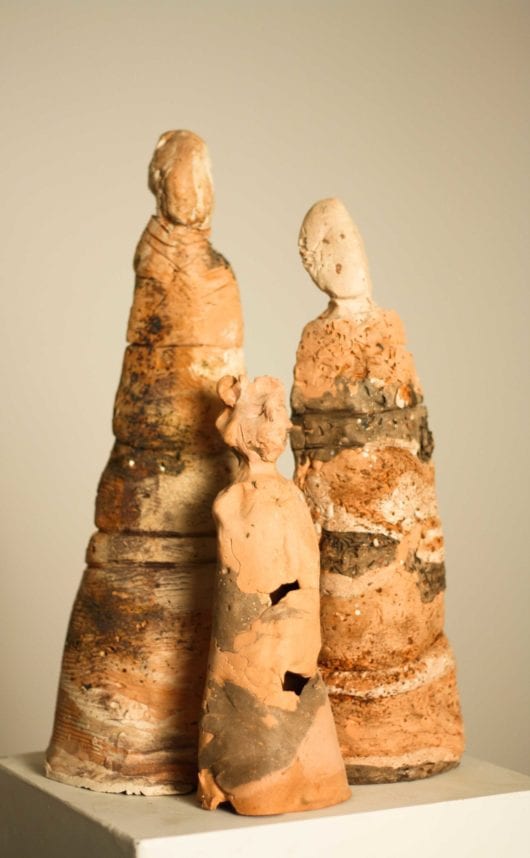
HOODOO FAMILY, GROUP OF 3 (FROM ARCHES)
Technique- Material: Multi-colored ceramic
Year: 2019-2020
The Survivor Series began when I returned from Hungary in search of family survivors. Most of my father›s family had perished.
The work was originally supposed to be a memorial to those who perished, but in the course of working on it, the focus changed to being about the process of survival, now dedicated to those who survive/d. It is about the lifelong challenge of living with and healing traumatic memories, about a life force that makes us want to live.
The miracle of our lives is that we do and can survive and are still able to feel life, compassion and love again. At a time when life on earth is fragile and in danger, we need to know more about the process of survival. I believe we have the intelligence, compassion and imagination to create a healthy survival.
ANNIE ALBAGLI
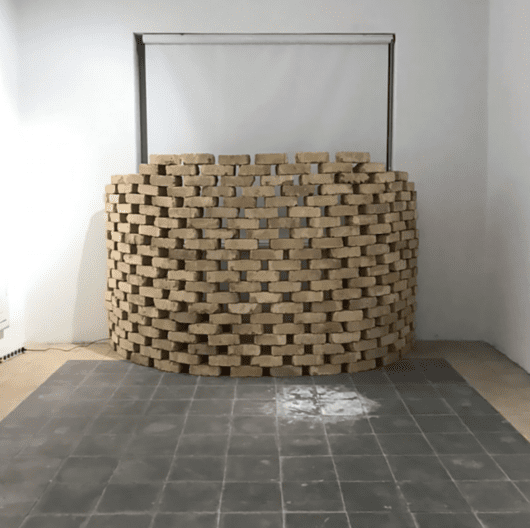
DISTANCE MOVING THROUGH ME: GISELLE AND MARCO
Technique- Material: Installation – Sound Art , 11:44 minutes
Year: 2015
Distance Moving Through Me relates the narrative of Giselle and Marco, a couple evicted from their homes and forced into exile in the 1950’s. At the time they chose to flea, Marco was arrested and held in prison, while Giselle’s family urged her to leave the country. She protested until the last moment; she did not know where her husband was and did not want to leave without him. I am interested in this moment of tension when Giselle decides to risk her life and move into the unknown; a choice made when it might feel impossible to see any form of future. In this moment do we restrict our mind or heart, our ability to feel out of a need to survive? Would we otherwise be paralyzed with feeling? Is emotional numbness a survival tool?
In its original form, this work consisted of an unfired brick wall littered with ice bricks that caused the wall to slowly disintegrate. It was a boundary that leaked and slowly crumbled and slumped to create an opening within the gallery. It was a reminder that even the strongest barriers give way to softness; whether emotional or structural. That leaky softness is mirrored in the end of this sound, when it appears that Giselle’s risk was worthwhile.
ARTISTS BEYOND BOUNDARIES
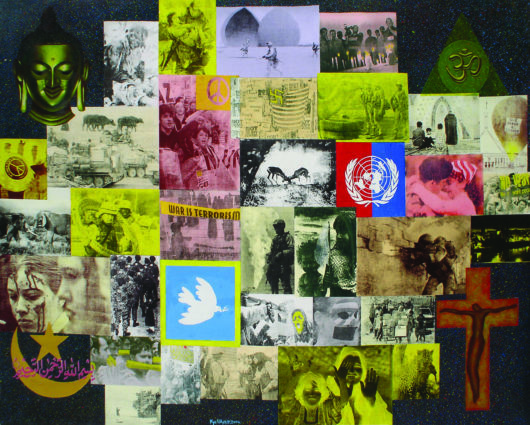
WAR & PEACE
Technique- Material: Silkscreen on canvas
Year: 2004
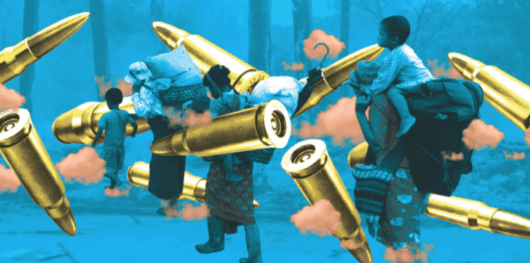 WAR & PEACE
WAR & PEACE
Technique- Material: photo silkscreen
Year: 2010
We are artists and educators who see visual art as a living, evolving force, and an important tool in our work to preserve all life, nature and the wild. Pamela Blotner and Mie Preckler make up the core of ABB, but our team expands to include local artists living in the areas and working with the issues of our concern. Both our collaborative and individual works document and celebrate our surrounding environments while also working to protect and propagate them. We believe that art must bring more than just ‘Awareness’ to the table, that if humankind is to take an active part in averting war, preventing, pestilence and stewarding our wildlife and wild places, we need to have a collective effort and mandate that is passed on from generation to generation. At a time when many international boundaries are turning into barriers, we believe that the arts and artists share a creative language that can heal and bring people together.
www.artistsbeyondboundaries.org
AZIN SERAJ

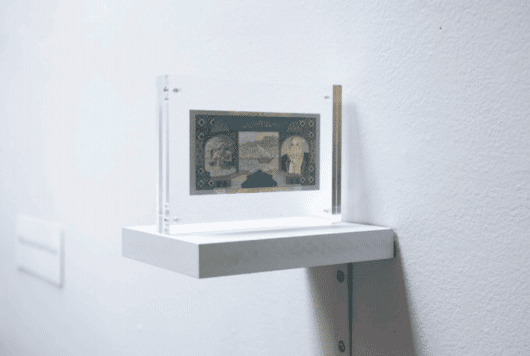
IN HONOR OF PALESTINIAN RESISTANCE
Technique- Material: paper, plexiglass
Year: 2018
Front: (1) Palestinian protesters in Gaza fleeing as Israeli forces fire a barrage of tear gas on May 14th. Photograph by Mohammed Abed. (2) Palestinian banknotes.
Back: (1) Nabi Musa (Prophet Moses) burial site in West Bank near Jericho, the most important Muslim pilgrimage in Palestine. (2) Muslim celebration in Gaza, 1943. (3) The Old Town, Gaza, Photography by Francis Frith, 1862-1863. (4) Arabic calligraphy. (5) Palestinian banknotes.
Each year Palestinians observe Nakba ‘the day of catastrophe’ to commemorate the forced removal of over 750,000 Palestinians from their homes and villages in 1948, during the establishment of Israel. During the Great March of Return, a tradition of Palestinian resistance since their removal, they raise black flags, pay respect to the ones who have been lost, and hold protests to raise awareness of ongoing injustice and the colonization of Palestinian lands.
This year, The Great March of Return began on March 30th and continued until May 15th to mark the 70th anniversary of the Nakba. The US unilaterally moved its embassy to Jerusalem on May 14th, a controversial action which violated established agreements and the spirit of the two-state solution. Despite widespread international condemnation, diplomats from 31 countries attended the opening ceremony. During protests near the Israel/Gaza border, Israeli forces killed over 124 Palestinians and wounded more than 13,000 people including children, members of the press, and crisis workers.
Inspired by the South African anti-apartheid movement, the Boycott, Divestment, Sanctions (BDS) movement is a Palestinian-led global campaign for freedom, justice and equality established in 2005. The BDS movement invites global citizens to stand in solidarity with Palestinians by participating in various forms of economic resistance against Israel until it withdrawals from the occupied territories, complies with international law, and grants Palestinians equality and the right to return home.
CAROL NEWBORG
 WORLD WIND MAP: STORMING EVERYWHERE NOW
WORLD WIND MAP: STORMING EVERYWHERE NOW
Technique- Material: Burnt Paper
Dimension: 9»H x 10.5»W
Year: 2020
Much of the damage to the earth brought by war comes from human efforts to control each other. We have instincts to compete and dominate which often seem to overshadow our instincts to cooperate and help our species survive. We continue to create toxic environments through bombs, chemicals and their residues, fires, and other displacements of war; all lead to great disruptions for each person affected and for the environment.
To me, the dichotomies of fighting and cooperating represent our situation as artists and activists in some ways. We can work to create peace and change, but we also find ourselves losing hope and our energy to work. While I continue to work in prisons through the arts to try to counteract mass incarceration and help individuals, I go from sharing and connecting deeply with other people to exhaustion and hopelessness.
Similarly, I continue to explore the beauty of wind patterns while also feeling ‘burnt out’ by the ever increasing destructive climate patterns they represent. The storms that are now always somewhere in our world represent human storms as well as environmental storms. I find that burning these patterns into paper is both a release of frustration and an expression of this reality. I deeply believe that we need to continue to work toward positive changes on many fronts, while we also need to acknowledge our exhaustion and numbness so that we can heal and keep working.
CHARMAINE LURCH
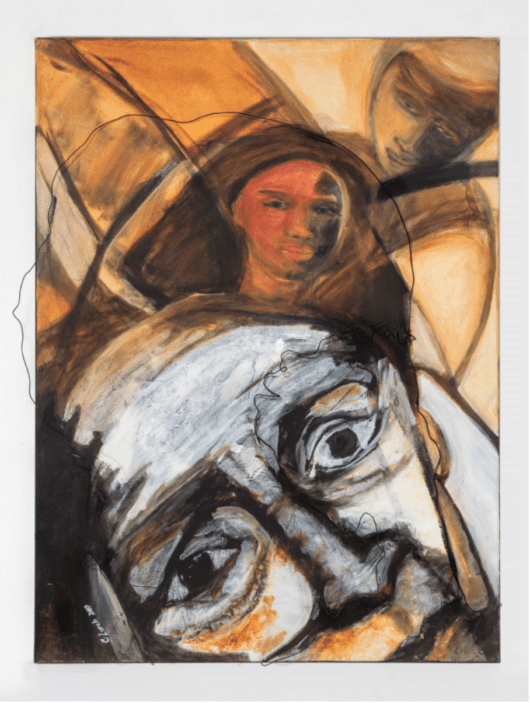
PUNCTUM
Technique- Material: Acrylic/wire on canvas
Dimension: 30 x 40 inch
Year: 2013
I have witnessed war’s effect from screens
that flick my eyes through fragmented perspectives.
And see too much, too fast, too hard, a resigned and repetitious violence, that shapes the suffering of people and things set in landscapes.
A dying punctuates time, Imaginaries unfold between perception and hallucination. I hang on to an image I once saw of children flying a kite in Lebanon, amongst withered trees set against resolute blue skies, and think on how people survive, full of dust and hardened lives.
This black skin is hard-pressed with the colonial manifestations of war, disguised in dog parks, subway trains and city streets that run through histories of displacement and forgetfulness. This scores my days, walls my way.
I anesthetize from this blistering,
The painting Punctum, is a reimagining, after Walter Benjamin’s, Ninth Thesis on the Philosophy of History, in which he describes Paul Klee’s 1920 monoprint titled Angelus Novus. His words help me to understand this work.
Here Angelus Novus as a Black woman, is positioned, as both observer and victim. This angel, faces a history of war through the growing body of killings of Black people today. She is poised, dynamic and static in a kind of fixed flux – between past and present. She envisions survival, away from the pile up, and catastrophes that display a violent chain of events, and moves through and away from the skyward progressions of trauma. Though pulled backwards, her wings opened, act as a detournement against the storm. She passes through this liminal space riding winds that circumnavigate and fan the flame of a positive new worldview and vision for all humanity.
CHRISTINA BERTEA
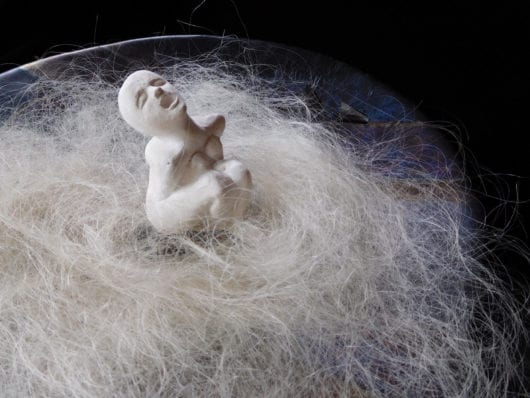 GASPING FOR AIR IN A SEA OF NUMBNESS
GASPING FOR AIR IN A SEA OF NUMBNESS
Technique- Material: assembled, figure and glass plate made in the 1990’s cast plaster figurine, artist’s gray hair, slumped and fused glass plate, black velvet
Year: 2020
When reality is too terrifying and unpredictable to endure nonstop day in and day out with no relief, we need to insulate ourselves from that emotional intensity. But insulating ourselves from our feelings leaves us numb—and numbness is intolerable in its own way. So many other feelings get drowned out too, along with the terror and dread. We become like walking dead.
This figure’s hair has turned gray from relentless stress and worry. She has pulled it strand by strand to numb herself— and to create a sea of calm around her to buffer her from the threatening storm.
Still, every once in a while she must come up for air, and allow her submerged emotions to surface and be expressed.
www.directory.weadartists.org/artist/christina-bertea
ELIZABETH KENNEDAY
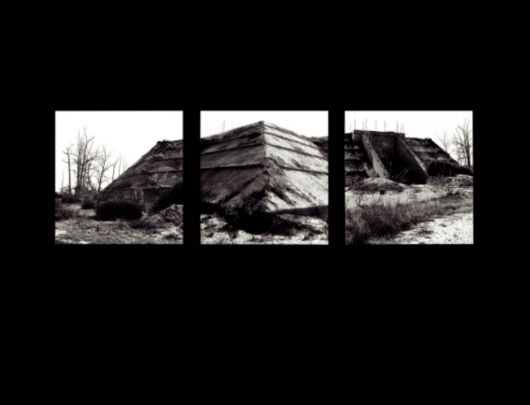
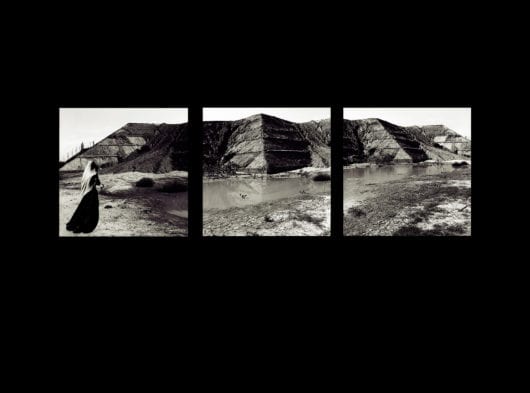 BOLSA CHICA BUNKERS
BOLSA CHICA BUNKERS
Technique- Material: Photographic Construction
Year: 2020
For a brief six years, a US military base occupied the mesa of the Bolsa Chica beach, wetlands and mesa land area situated along the Pacific Ocean coast in southern California. The bombing of US Naval Base Pearl Harbor by the Japanese government in December 1941 prompted the establishment of a Military Reservation in 1942 to protect the coastline from enemy vessels. Two 155mm guns capable of launching a one-ton shell 28 miles into the Pacific Ocean, were installed. They were never fired in combat.
In addition to the gun emplacements, other structures were built, including the massive concrete bunkers depicted in this imagery to store munitions and house personnel.
Deactivation of the base in 1948 left polluted waters in the wetlands that exchange flow with the Pacific Ocean and are home to hundreds of species of waterfowl, as well as flyover species; contaminated soil on the mesa, where raptors nest above the wetlands; and toxic hazard ‘hotspots’ of unexploded munitions and ordinances.
After World War II ended, Bolsa Chica was bitterly contested by land developers wanting to build homes on valuable southern California coastal land and environmentalists seeking to preserve the ecologically unique wetlands and mesa complex. The need for extensive restoration in the wake of the military occupation sidelined development capability, allowing environmentalists to effect the establishment of the Bolsa Chica Ecological Reserve in 1979, protecting the wetlands. The southwestern edge directly of the mesa above the wetlands was added to the Reserve in 1997, with the remaining mesa ceded to land developers.
To date, $191,000USD has been spent on the cleanup of hazardous sites at this installation with an estimated $12,300,000USD required to complete the process. Final Cleanup Action is slated for September of 2048 with ongoing monitoring of the site continuing until September 2078.
FARZANEH NAJAFI
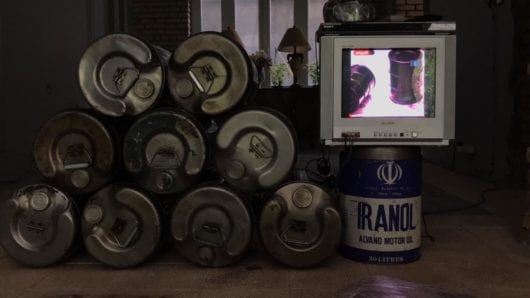 THE WAR OF THE OIL
THE WAR OF THE OIL
Technique- Material: Installation – Video
Year: 2020
Oil, this black gold is the motive for seizure and plunder many lands all over the world. The Middle East is the focal point for world superpowers due to the existence of such oil reserves in this region. The United States, presently, is placed on the top of the pyramid, having the power and suppresses many other countries to intensify its emphasis on the sanctions against Iran. The sanctions not only challenged the Iranian economy, but even had irreversible impacts on the increasing devastation of the environment of Iran and the world as a whole. The lengthy lines of people demanding kerosene during the Iran-Iraq war have nowadays changed into waiting for exchanging stocks. A considerable portion of the stock market is owned by oil companies and refineries. These companies which depend on oil products have offered a portion of their values as stock and during recent months and people spend long hours in the lines for stock exchanging per day. Unfortunately, increasing sanctions intensity causes economic issues, therefore Iran’s endeavor to produce a greater amount would lead to demolition of the environment and spreading contaminants, and consequently non-compensable damage of the environment.
The work is formed of an installation using 9 old 20-liter oil barrels and a video projection set. A video of the lines of selling and buying stocks offered by oil production companies in the stock market of Iran is shown. The time designated to the video that is supposed to be played on parts of the body of the barrels is 60 second.
GAZELLE SAMIZAY & LABKHAND OLFATMANESH

BEPAR (HOP)
Technique- Material: Video, 6:00 min
Year: 2019
The series Woven is a collaboration between Labkhand Olfatmanesh and Gazelle Samizay and comprises of photographs, collages, and video. The particularities of our experiences as women of Afghan and Iranian heritage fed our collaboration, though Gazelle grew up in the US and Labkhand grew up in Iran. We are interested in the way cultural expectations and the effects of war transcend borders and affect women despite their location. In Bepar the shattering effects of war and patriarchy on a young girl’s journey to adulthood are illuminated through the game of hopscotch (named «lay lay» in Iran and «joz baazi» in Afghanistan).
www.gazellesamizay.com
www.labbiemanesh.com
GEM BEILA ROSENBERG
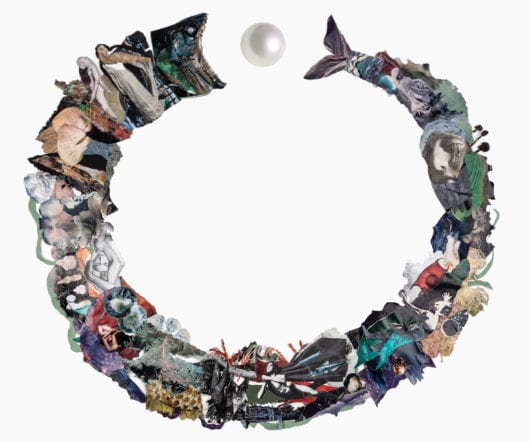
OUROBOROS
Technique- Material: collage on paper
Year: 2019
Lunar Sea, a series by Brooklyn-based interdisciplinary artist, Gem Rosenberg, explores the relationship between humans and the environment inspired by our shared elements and cycles. All life began in the sea, just as we begin our lives in a womb as part human, part «fish». Most fluids of the human body are biochemically similar to seawater. The moon influences the tides, ocean life, ancient and contemporary culture. Rosenberg uses mixed-media collage as an ecofeminist exploration inspired by marine biology, myth and spiritual lunar connection. The sea contains life and death, with a rhythm that calls us home to ourselves, cleansing and attuning us. Yet, it is an inconceivable expanse, sometimes, ferociously wild.
The ocean is a mirror and a metaphor for the self, embracing light, mystery, shadow, and depth. From a place of safety, Lunar Sea gently challenges the emotional numbness that can arise from trauma in favor of vulnerability. Water is a powerful source of nurturance on this path to transformation.
There are many examples of feminine archetypes associated with the Sea such as Aphrodite (Greece), the Virgin Mary (sometimes referred to as Our Lady, Star of the Sea), Yemoja (Yoruba), and Sedna (Inuit), revealing how the ocean has cross-cultural associations with divine femininity throughout time. Imagined feminine archetypes float in and out of convention, always somehow rooted in a landscape that is uniquely her as much as she is it. It is this lack of separation between self and environment that shows our simultaneous destruction as an opportunity for healing and completeness.
JEANNE WILKINSON
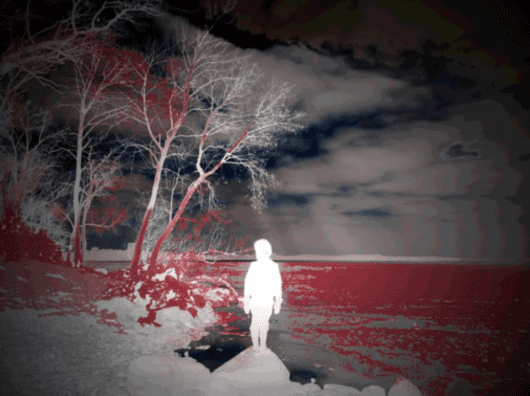 BLOODLAKE 2
BLOODLAKE 2
Technique- Material: Archival pigment print of photographs of beach plastic toy soldiers
Year: 2013
In these two artworks, I depict a world filled with blood, lit by a sun that has become a source of darkness rather than light. In one, a benumbed child stands on rocks that have become cold and sterile under his feet, his world no longer one of sustenance and color, but depleted and drained. This is how I see the earth and our place in it as wars, weapons, pollution and the greed that drives all these forces to grow and proliferate. It’s as if we are filling the earth with our blood while draining our own existence of life and light.
JUDITH SELBY LANG AND RICHARD LANG
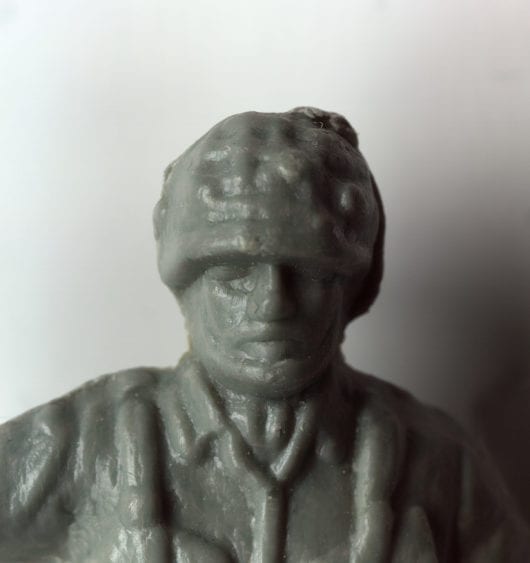
THE TRUE COST OF PLASTIC
Technique- Material: Archival pigment print of photographs of beach plastic toy soldiers
Year: 2013
Through the years, from Kehoe Beach, in the Point Reyes National Seashore, in Northern California, we have amassed quite a collection of plastic toy soldiers plus Cowboys & Indians, space-men, and pirates that chronicle the history of world conflicts. To date, we have well over 200 from Japan, Korea, China, and from gutters around the San Francisco Bay Area that have washed up onto the beach. The miniature helmets and weapons make it clear that war is our subtext and whether it is the internal disagreements of life’s decision-making or real war, these little figures are a way for the psyche to play; to imagine the impact of combat.
Now home from the war, wracked by a long life at sea, some of the faces are gnarled, chewed on, abraded by the sand. When we looked into their tiny faces we were amazed by their expressions. Each soldier is a poignant reminder of the ravages of war and the extremes to which nations will go to preserve dominion over the petrochemical world. Is plastic still cheap when the cost of war is added to the calculation?
We are dedicated to expressing the narrative of life and have found the creation of images of the human visage the most compelling way to tell stories about that journey.
KAMALA PLATT
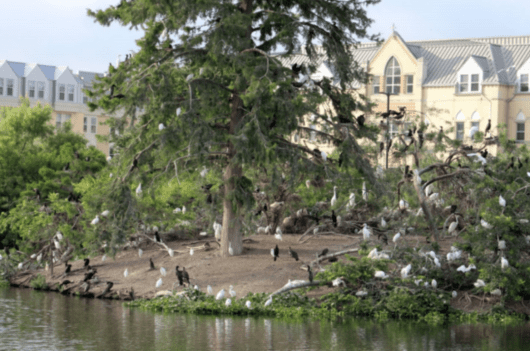
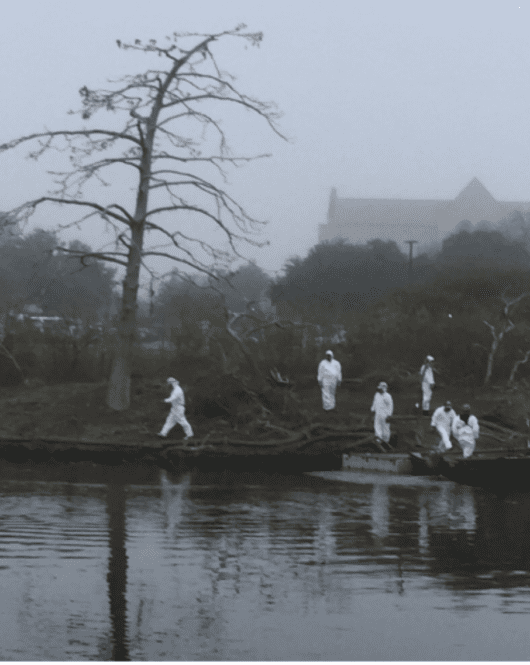 BIRD ISLAND DIPTYCH: i. Summer Pachanga
BIRD ISLAND DIPTYCH: i. Summer Pachanga
Technique- Material: Photography
Year: 2019-2020
- Halcyon Hellscape after Advent Attacks
‘Bird Island Diptych I & II ‘ consists of two 2019 photographs that I took a few months apart of an island in Elmendorf Lake, a small water body in a city park in San Antonio’s Westside barrio. ‘Bird Island,’named generations back by the local community, was home to a heronry pictured in ‘I. Summer Pachanga. It has been an ecological-cultural fixture to the surrounding neighborhoods and a nesting ground for migratory egrets, herons and cormorants for decades.’ A cypress, and other Texas native trees held stick platform nests that were reused each nesting season.
In league with a displacement war happening in communities and habitats, worldwide, local plans to eliminate San Antonio’s heronry developed by the City, its military bases and the US Dept. of Agriculture were delayed in February 2019 by eggs in a Great Heron nest. ‘Summer Pachanga’ reveals the final nesting year at Bird Island. However the habitat destruction and pyrotechnic harassment were carried out beginning December, 2019; they resumed when migratory birds returned in Spring 2020, under Covid 19 Stay at Home orders . ‘Halcyon Hellscape ‘ reveals the denuded island on a foggy morning after removal of nests and flora.
As home to white egrets, Bird Island evokes Aztlan, Place of White Herons, an intracontinental, legendary, northern homeland for Mexican peoples. Aztlan is where those who immigrated south to the Valley of Mexico (now, México City) originated. Chican@ communities across Greater Mexico in the U.S. identify local ‘Atzlans’ like Bird Island. In late 20th/ early 21st Century Chicana writing, Aztlan configures connections to Indigenous land, evoking memories that walk us through emotional numbness to commemorate struggles against wars on native lands and peoples. They celebrate contemporary Indigenous, Queer, Mestiza communities that continue struggles of conscience against wars’ violence.
www.directory.weadartists.org/artist/kamala
KATYA GROKHOVSKY
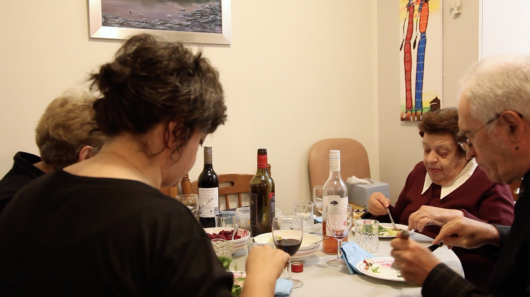
THE FUTURE IS BRIGHT
Technique- Material: Video 3:17 min
Year: 2018
The Future is Bright is a video, which explores disillusion, war trauma, migration, identity, re-discovery and the failed utopian promise of ideology through the artist›s family’s history. Focusing around the narrative of the character of Grokhovsky›s 95 year old only surviving grandmother, a veteran of World War II, the project investigates post-traumatic generational identity formation through an extraordinary story of survival, humanity and legacy.
LAURA PHELPS ROGERS
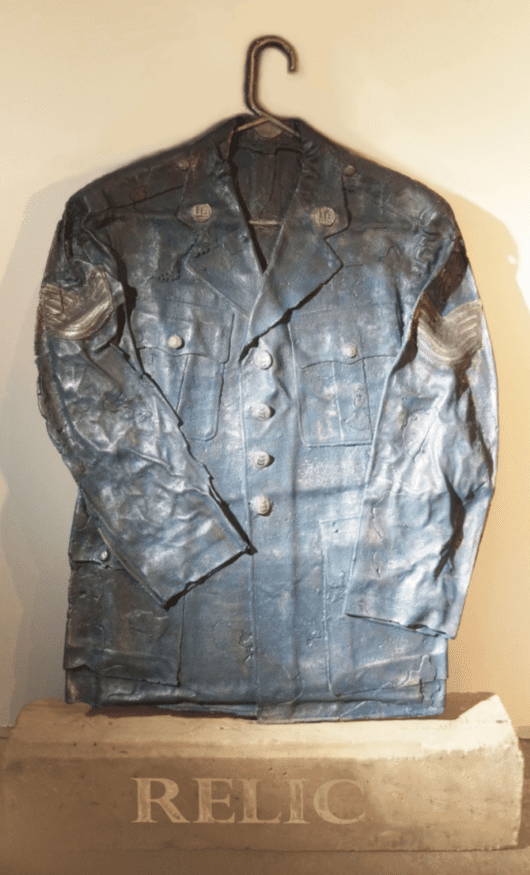
FULL METAL JACKET
Technique- Material: Digital Photograph of Sculpture, Cast Iron and Found Object
Year: 2010
This work was created specifically in response to a Dadaist exercise where the artist drew the words jacket and air. Having just lost her father, the work started as a memorialization of his service in WWII and Korea and expanded to her own memories of the Vietnam War. It is a memory-based work that creates a universal memory of loss and service. With the world’s greatest environmental losses derived from the nuclear weaponry of WWII and the some of the earliest litigable environmental impacts on human life experienced through defoliation in the Vietnam War from the use of Agent Orange, these memories serve as staunch environmental reminders of how armed conflicts around the world have consequences beyond loss of life. The constant of the human components of war are highlighted in this work.
MANA SALEHI
 FLUTE OF LOVE
FLUTE OF LOVE
Technique- Material: Video and sound – 2 minutes and 1 second
Year: 2019
This video is recorded in Sufi Kandi landscape, province of West Azerbaijan, on the border of Iran, Armenia and Azerbaijan.
Karabakh War in Armenia and Azerbaijan took place in the late 1988s to May 1994. All their disagreements between them begin at the time of the First World War. The rivalry over control of the border, ethnic and historical differences in the Zanzibar Mountains (Nakhchivan) led to fierce clashes between the first Republic of Armenia and the Democratic Republic of Azerbaijan. Even Iran that has borders with them could not have a position to help settle conflicts and reach an end to peace.
There, I walk along a path without memories, alone with my own presence, beyond borders and wars.
MARGUERITE ELLIOT
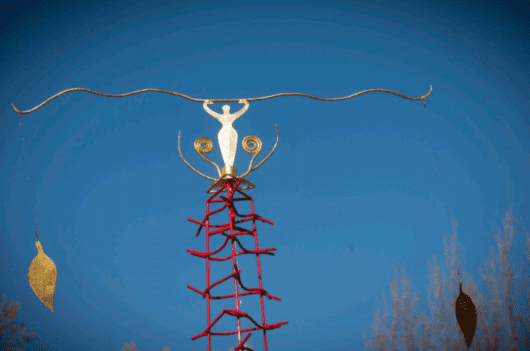

CALIFORNIA SENTINEL: ECO-WARRIOR
Technique- Material: Steel, Gold Leaf, Wire
Year: 2019
My Sentinels stand guard as a witness or protector of our sacred lands. Using ancient icons to send out warnings or healing energy.
Growing up on a small farm in rural Virginia, I spent many hours walking through fields and along stream banks. This was my first experience deeply connecting to the earth. I feel a deep affinity with nature and the natural cycle of life. My art today has a direct connection to my years growing up in the country. As an artist, I work with steel and natural objects such as seedpods, leaves, and small stones. Although the intense heat of my welding torch transforms the steel, melting and bending it, even steel is transitory, eventually rusting away to nothing.
Concerned with the current environmental destruction, loss of species, and irrevocable environmental changes taking place all over the world, my work functions as both a reliquary and a shrine, to what is lost or soon may be lost.
SENTINELS: PROTECTORS OF WILD AND BEAUTIFUL PLACES
My new series of large outdoor public sculptures is titled Sentinels. My sentinels keep watch or stand guard over our sacred lands but also symbolize the interface between technology and the environment. Inspired by the ubiquitous cell phones towers in our lives today, they also incorporate iconic images from ancient civilizations. Drawing energy from the earth, these Sentinels simultaneously broadcast warnings about the climate destruction we now face due to war, loss of natural habitats, and warming oceans, while sending out waves of healing energy.
MARY B. WHITE
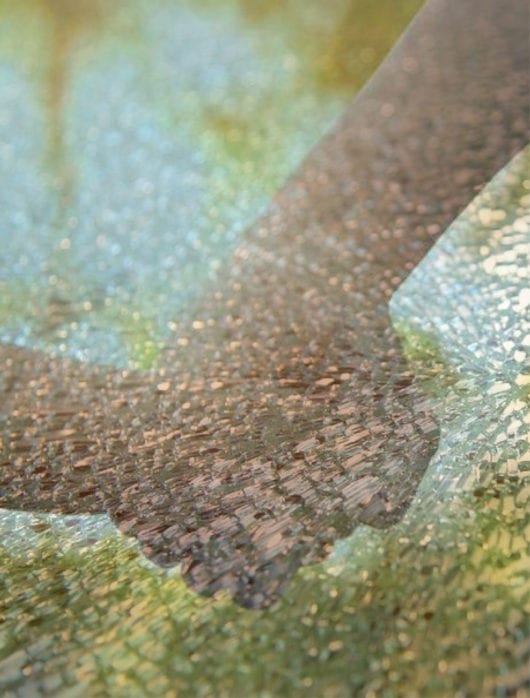
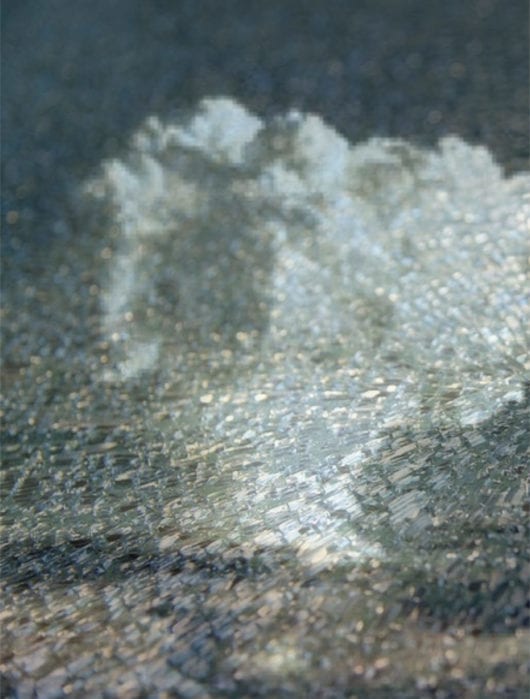
LOOKING BEYOND THE SHATTER
Technique- Material: Digital Photography
Year: 2020
At this time in my life and career as an artist, I am most interested in the intersection of art making, natural sciences, environmental perception, arts education, social justice and peace making.
For 32 years I lived with an atomic vet, who joined the Navy when he was 17. Before his 18th birthday, had been on a guard boat within 30 miles of 20 atomic bomb tests in the Johnson Islands Biki Atoll. He witnesses birds and people blinded by the bombs, the destruction of islands and habitats, the effects of Hiroshima and Nagasaki on citizens. He dreamed nightly of the bombs till he died of the effects of the early radiation. These pieces are looking at the fragmentation that war brings, that freezes us from feeling. We must see beyond the shatter to hope.
MICHELE PRED
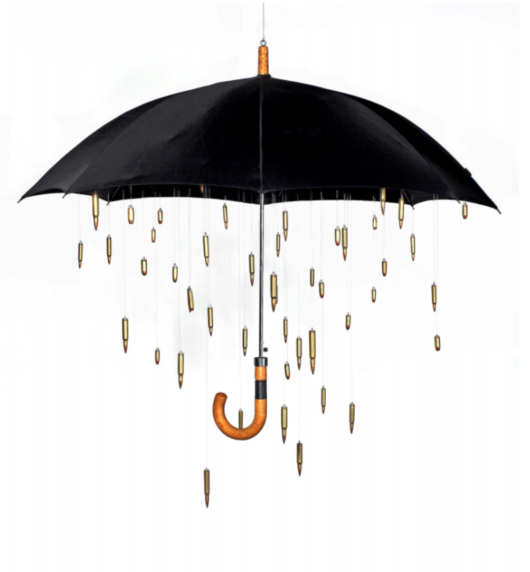
SECURITY STORM
Technique- Material: Umbrella, Bullets and monofilament
Year: 2016
Security Storm is a suspended umbrella with bullets of varying sizes raining down beneath. The arraignment asks us to consider what it means to be protected and feel secure as well as ask who is providing that protection. The bullets are also a stark reminder of how immersed in gun-culture we are here in the United States. We are virtually swimming in a sea of ‘protection’, yet, as a nation, we feel increasingly vulnerable.
MICHELLE ECHENIQUE
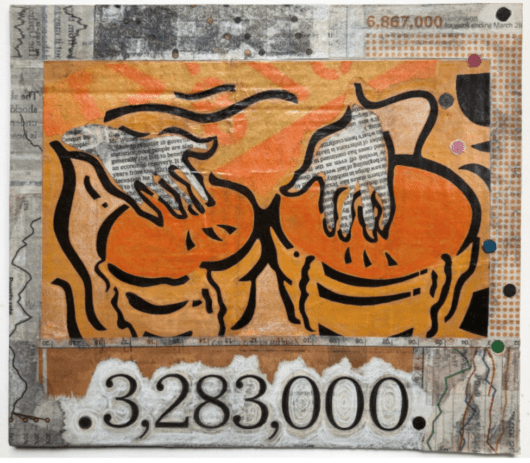 DRUMBEAT
DRUMBEAT
Technique- Material: paper collage
Year: 2020
Drumbeat references the ‘drumbeat of bad news’ that was and continues to come at us from every direction. While the onslaught can be numbing the words nevertheless saturate our bodies and affect our state of being.
San Francisco based artist, Michelle Echenique utilizes found material in her mixed media work. Using throwaways is key to the work’s impact and intention. She revels in the challenge of repurposing, reshaping and redefining recognizable material inviting a new read on the familiar. Contextualizing work within a place’s natural and human history unites a current sense of time with its past and invites dynamic consideration of how current circumstance is shaped by what came before.
The submitted works are part of the Corona Chronicles, a series started in mid-March immediately following the shelter in place order. The purpose was to record this unprecedented time utilizing daily newspapers in conjunction with other relevant paper. This is a world war fought against a virus. Although a different enemy this battle has impacts similar to traditional conflicts: death, displacement and suffering, laying bare inequities.
MICHELLE WATERS
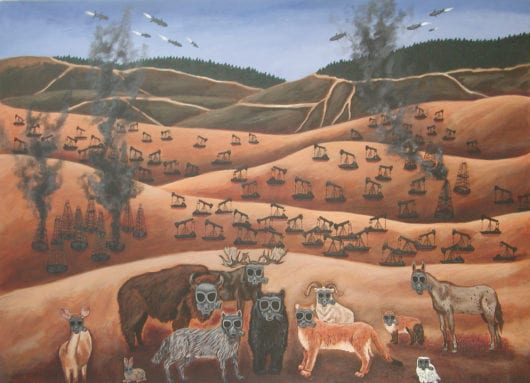 LAND OF THE FREE
LAND OF THE FREE
Technique- Material: Acrylic on canvas
Year: 2005
I painted «Land of the Free» right after Hurricane Katrina, when the ramifications of our addiction to fossil fuels – endless resource wars, environmental destruction and greatly intensified weather events – started coming home to roost. The animals in the foreground are victims of humanity›s incessant plundering of the Earth. The Earth is their home, too, but they have no recourse and nowhere to take shelter as our planet is swallowed up by oil production, weaponry, and resource extraction.
NADIA SKORDOPOULOU
 TROJAN HORSE
TROJAN HORSE
Technique- Material: Photography
Year: 2020
The work is an artistic installation made of materials I collected on the beach such as reeds. It is called The Trojan Horse is a story from the Trojan War about the subterfuge that the Greeks used to enter the independent city of Troy and win the war. Metaphorically, a «Trojan horse» has come to mean any trick or stratagem that causes a target to invite a foe into a securely protected bastion or place. The event is also referred to in Homer›s Odyssey. In the Greek tradition, the horse is called the «wooden horse» ( δοÏÏειος ἵππος, doúreios hÃppos in Attic Greek). So in a way the work suggests a lack of trust between nations.
www.nadiaskordopoulou.wordpress.com
NANETTE WYLDE
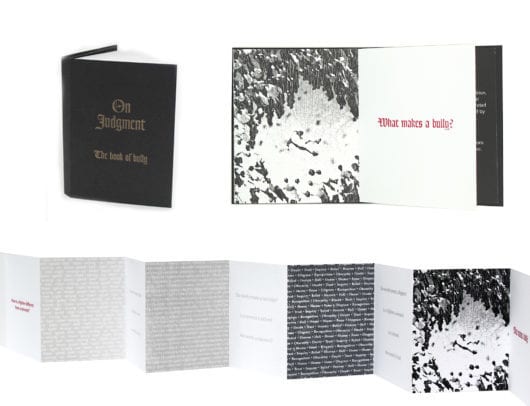
ON JUDGEMENT: THE BOOK OF BULLY
Technique- Material: Artist’s Book, accordion format made from hand pulled wood relief prints on Somerset Black Velvet and Somerset Velvet.
Dimensions: 11.7475x 14.605x 1.27mm closed. 14.605x 137.16 open/extended.
Year: 2012
What makes a bully?
How is a bully different from a fighter?
How is a fighter different from a terrorist?
Do words create a bully? Is a bully a victim? Are words knowing?
Do words create a terrorist? Is a terrorist a victim? Are words judgment?
Do words create a fighter? Is a fighter a winner (or a loser)? Are words true?
What makes a bully?
On Judgment: The Book of Bully was created for An Inventory of Al-Mutanabbi Street, a project of The Al-Mutanabbi Street Coalition, a global book arts response to the car bombing of Al-Mutanabbi Street in Baghdad on March 5, 2007.
Pondering the sources and causes of the destruction of Al-Mutanabbi Street and what this act really was about, at its essence, creates more questions for me than it does provide answers. Considering parallels and relationships is one way of thinking through the problem.
In designing the book I wanted aspects of the form to communicate aspects of the complexity of the content, that are not overtly stated in the text. I chose wood relief because I wanted the look of the pages to have a hand-printed aesthetic to reflect the long history of books, the printed word, and the street itself.
NAZIL ABBASPOUR

HOW MANY BIRTHS ARE GIVEN, TO DIE SO REPEATEDLY?
Technique- Material: Installation
Year: 2017
I am an artist from Iran in the Middle East. My whole life, I have been plagued by wars in my or neighboring countries. And so, the word ‹war› has become synonymous with the Middle East. In addition to physical and psychological damage, war has had devastating effect on the environment. Today, many years after the Iran-Iraq war, the soil of this land has been ravaged by environmental afflictions resulting from this destructive war. Besides that, today, human kind suffers from unexpressed and concealed emotions. The multifaceted digital media because of their wide reach and constant availability, publish news of war and destruction all over the world on a daily basis. We are therefore exposed to repetitive false news and information every day and by coming into the habit of disregarding our feelings toward our damaged world and environment, we gradually lose our sensitivity and become passive elements.
NOOSHIN NAFICI
SHELTER
Technique- Material: Installation, Wire, cloth, natural color
Year: 2020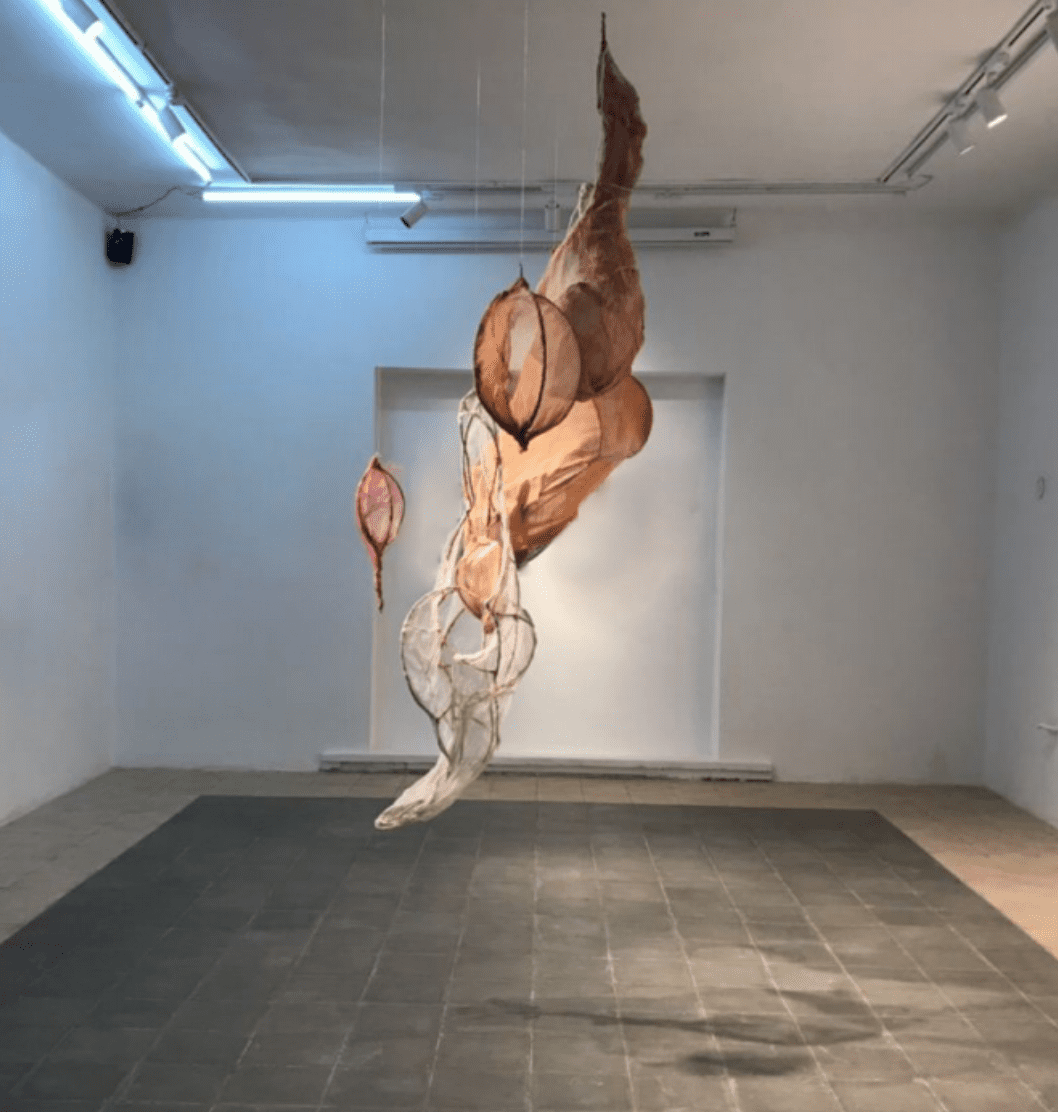
SHELTER
Technique- Material: Installation, Wire, cloth, natural color
Year: 2020
The world is in turmoil. Defenselessness, devastation, homelessness, immigration and feeling of insecurity has spread. We want to take refuge in a place that makes us feel safe, covers us, keeps us together, we want to have a cozy place where we can gather in ourselves and find peace.
‘Shelter’ is often a tiny place that may be built in circumstances of war, in the mountains, in snow and in harsh situations as a temporary way to survive emergencies. It is an extremely primitive, simple, equipment-free structure that resembles an animal›s nest.
Shelters which cover but also reveal the body. Shelters which are protective but also floating and unstable. It is the shell and the body as well as a shelter for the soul
REVITAL KATZNELSON
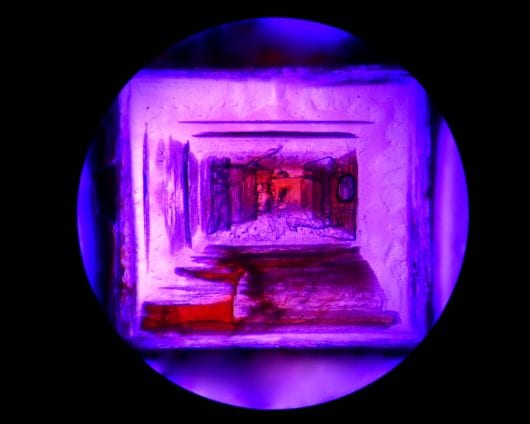
WAR ZONE
Technique- Material: Photograph
Year: 2019
This image captured the intricate detail of a unique salt crystal through the microscope at 50x magnification. As the crystal precipitated from olive brine, the natural olive pigments were compartmentalized within the irregular physical structure, creating patterns, shadows, and spaces full of memories. I saw the Sheikh’s Tombs and the demolished villages of the Galilee and the occupied West Bank, and I saw figures in torn landscapes. The War Zone that came to mind would not have been there at all if peace makers on both sides in this Zone had enough power.
R.R. PASCOE
 UNTITLED
UNTITLED
Technique- Material: Assemblage, Photography
Year: 2012
Assemblage artwork portraying the long shadow of war on childhood and whimsy. Exploring the mythology of duty, heroism, glory and the many and varied societal fairy tales that we tell ourselves in order to be able to live with the realities of war. Constructed from my daughters broken jewelry box, my grandfather›s WW2 medals, and a found toy soldier.
ROYA EBTEHAJ
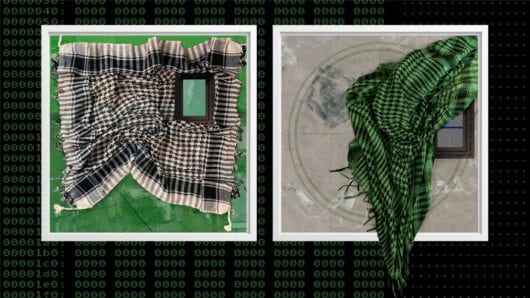 ALMA MATER
ALMA MATER
Technique- Material: Digital video/3D animation
Year: 2020
As an artist experimenting with Computer Graphic software I noticed many similarities between the tools I use and modern military technology. This resemblance reminds me of how technology can be misused for destructive purposes and so much of modern war is justified by inaccurate prejudices.
Alma Mater portrays conflicts in the Middle East dependent on exploitation of resources, technological advancement and cultural stereotypes. In this GIF, I wanted to highlight the way these factors have shaped modern warfare.
SALMA ARASTU
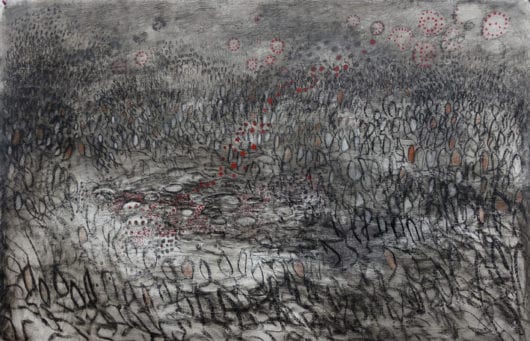
PANDEMIC
Technique- Material: Drawing, Charcoal on canvas
Year: 2020
This drawing on canvas was created when we started watching impacts of CoronaVirus first in New York in March, 2020. It was shocking and scary. I was numb and shaken. I wrote-
This is the world war three
Of 21st Century
Our enemy is invisible
Attacking us from front and back, left and right
You cannot use your top of the line weapons
Technical Intelligence or diplomacy
Helpless we either surrender or die
And the next day I pulled out a large canvas piece 40’/60′ nailed it on the wall and drew with charcoal, the destruction caused by these attacks from the invisible enemy Covid19.
My works are lyrical, spiritual, figurative, and calligraphic. My paintings reveal stories of unity in diversity, peace and joy and celebration of life. Whether in paintings or sculptures, the faceless figures represent the universal oneness of all humanity.
Line is a very important component in my work. I celebrate energy and movement of line in my paintings, drawings, and sculptures. Since my exposure to Arabic calligraphy during my stay in the Middle East, my line has become more lyrical, melodious, and powerful.
The lines I create represent the spiritual energy that emanates from a soul. I use the same stroke of the brush for Arabic letters as I do for suggesting human forms. Both are fluid as if temporary expressions of the eternal universal energy.
Arabic Calligraphy, miniatures, and the folk art of Islam and the Hindu tradition continue to influence my work today. I have tried to bring together Eastern spirituality and Western techniques of painting learned over the years. Through the contrasting elements in my work, I yearn and search for unity, and when that unity or balance is achieved, it brings about tranquility and joy.
I am blessed because I was born with the urge to create and a love for God. These two gifts have been sources of eternal joy and a constant flow of positive inspiration in my life. My mission is to spread this joy and blessings that I have received among all through my work.
SARA MADANDAR
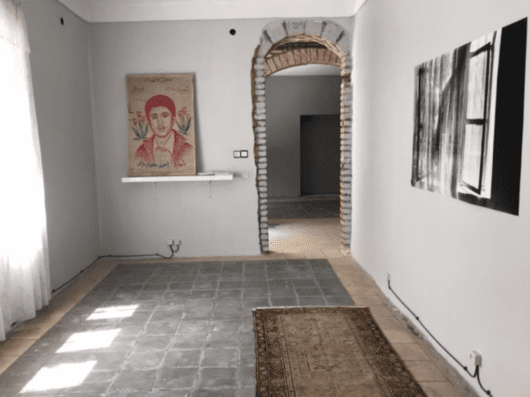
IN MEMORY OF AZIZ
Technique- Material: Installation
Year: 2020
In this installation titled In Memory of Aziz, Madandar creates a nostalgic space inspired by memories of her grandmother’s house in Iran. The artist’s mother, in trying to maintain the memory of Aziz, the grandmother, has kept the house and furniture as it was eighteen years ago when Aziz passed away. The installation consists of objects, a video, photo, and a painting. The objects installed here are all actual objects borrowed from the house, and the video and photo were also shot in that space. The painting was painted about 37 years ago after Madandar’s uncle Ahmad, was martyred in the Iran-Iraq war in 1982. The letters were written by Ahmad in the war. In one of the letters, he described the process of sending him to the war. Ahmad was the last child of the family and was 17 years old. He left the house to the war without telling anybody, just one of his brothers. Shortly after that he wrote the last letter which is his will and said goodbye. The audio in this installation is Madandar’s mother voice reading the letters.
SHARON SISKIN
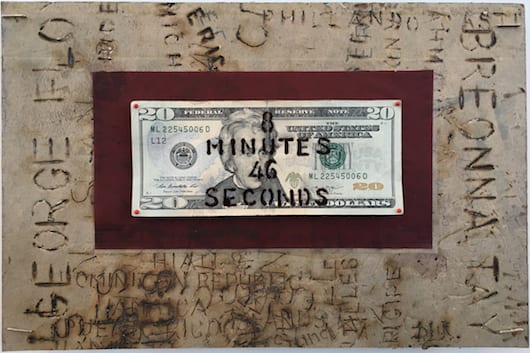
RUDE AWAKENING
Technique- Material: US $20 paper bill, vinyl film, cardboard, burnt text
Year: 2020
American culture is one that exemplifies emotional numbness to much of the suffering of the world—climate emergency, deforestation, species extinction, wars in other parts of the world, and even the daily war in our country caused by centuries of systematic racism in the form of violence and murder against Black Americans, other people of color and the indigenous people of the land we colonize. To be honest, most Americans are callous or blissfully ignorant of the more than a dozen wars that have involved the United States in the 21st Century or US tensions with countries in the East and Middle East, including Iran.
This piece considers the war much closer to home. It is the one we see everyday with our own eyes all over our country—systematic and institutionalized racism. Rude Awakening is about the recent fractures in our emotional numbness as it relates to systemic and institutionalized racism, when on May 25, 2020, George Floyd, a Black American man was killed during an arrest after allegedly passing a counterfeit $20 bill in Minneapolis. A white police officer, Derek Chauvin, knelt on Floyd›s neck for eight minutes and forty-six seconds. Witnesses’ videos of that American tragedy went immediately viral, fracturing the emotional numbness in this country, awakening American citizens and giving birth to anti-racist uprisings all over the country that have continued. Perhaps this recent rude awakening will spark a global awareness among Americans and motivate more of us to take action beyond our borders.
SHIRIN KHALATBARI
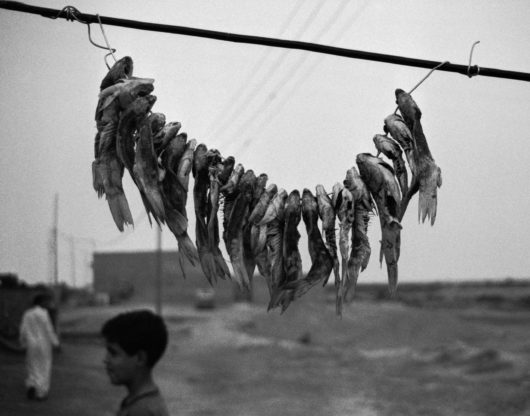
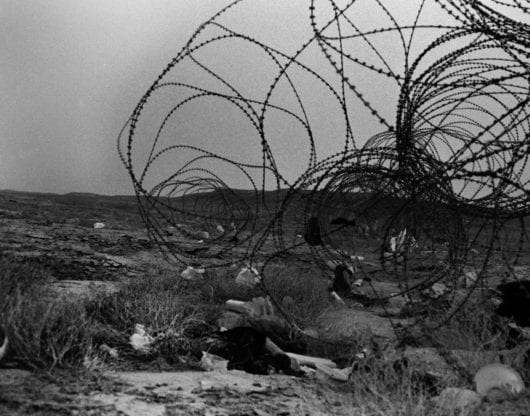
FOOTPRINT
Technique- Material: Photography
Year: 2015
Driving north-east from Basra Airport, as far as the eye can see there is nothing but the black smoke of the refineries billowing into the air. Both sides of the road are awash with rubbish and debris. After about three hours of driving and just a few kilometers east of the River Euphrates and the city of Nasiriyah, one finds oneself in front of the last remnants of one of the world’s first true cities, Ur. Inhabited from 5,500 B.C., the city of Ur had a prominent role in the political, religious, and economic activities of the Mesopotamian floodplain. Around three millennia after the first settlement in Ur, stability vanished from the city and was never to return. From then on, countless generations have never known peace.
This is how Ur looks today.
SHOLEH ASGARY
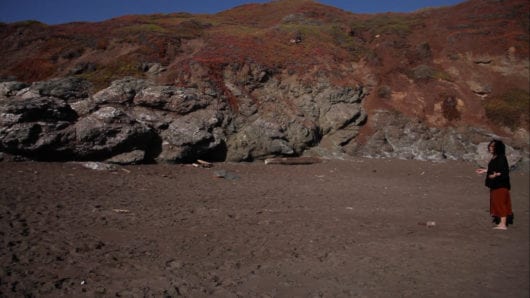 BLOOP
BLOOP
Technique- Material: Video, 7:47 minutes
Year: 2020
Separated by the ocean, ‘Bloop’ is the reverberation of the bombs that created a generation. An audience participatory score performed as a movement with eyes closed, parallel to the ocean, the following three actions are repeated in order, until out of the camera’s frame: 1. Throw the provided rock forward. 2. Imitate the sound of the rock’s landing. 3. Locate the rock and refer back to action 1. The deficiency in translating this experience can be seen as a contrast point of humor against the trauma of warfare. ‘Bloop’ empowers the performer to simultaneously mock and make oneself vulnerable, exorcising out of our body the weight and levity of warfare into an intimate and personal exercise, casting a rock like a bomb, reversing its power into an anti-climatic drop, and unremarkable plop, the opposite of a bombs devastation. ‘Bloop’ is the playful parallel, the blind search, the banality that comes out of the strife of warfare.
SUE HETTMANSPERGER
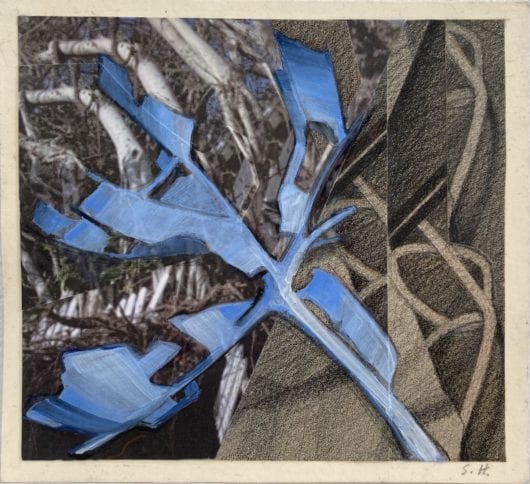
UNTITLED
Technique- Material: photo of a collage using digital photos, lithographs and hand oil painting on paper surface
Dimension: 5′ x 7′
Year: 2020
The paintings and drawings I make continue a lifelong interest in biological systems, botany, and the complex relationship of humans to their environment in the era of the anthropocene. We are increasingly aware of the potential for the natural world to be impacted, to mutate and morph into arresting new configurations, provoking thought about cultural attitudes and perceptions of our place within nature. As I explore the interdependence of human and botanical, organic and inorganic systems in a conflicted embrace, my work evokes ecological concepts and sustainability concerns that are at the heart of creative and analytical discourse today. These artworks explore the beauty and pain of the visual world and fraught connections between living things.
TAMMY WEST
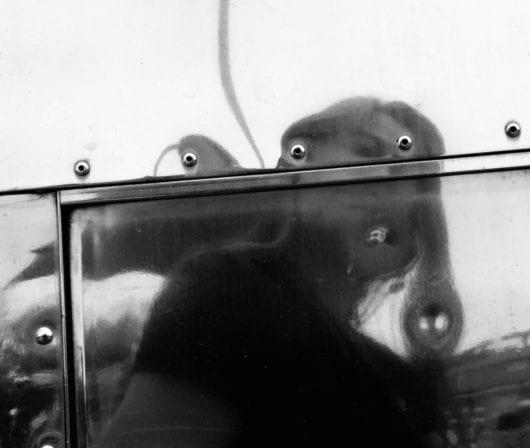 SHOT-FEELING ON THE OUTSIDE
SHOT-FEELING ON THE OUTSIDE
Technique- Material: Digital Photograph
Year: 2019
This piece uses the reflection of myself on distorted metal and rivets to convey the emotional effects of war, the fear of being shot, and the PTSD that comes from living in a war zone. I intentionally situated one of the rivets on my forehead to imply a gunshot to the head. The distortion of my face is meant to show the emotional effects of war, occupation and the forced migration of culture and people.
VERONA FONTE
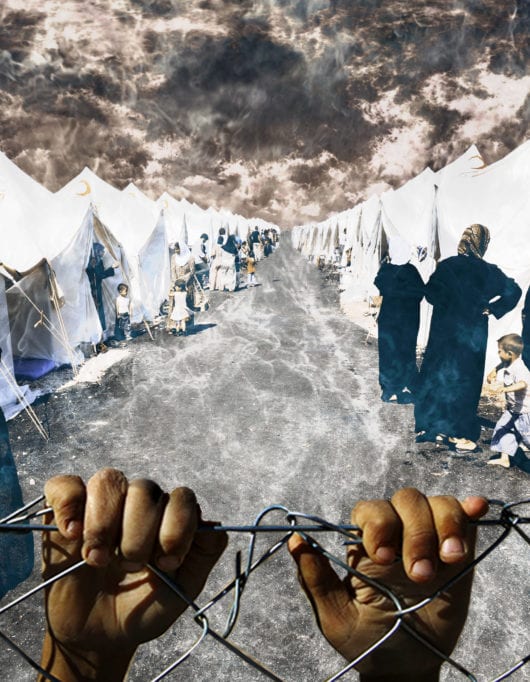
SYRIAN REFUGEE CAMP
Technique- Material: Digital Image
Year: 2016
‘Escape From Fire: The Migration Crisis of the 21st Century» a series focused on the dramatic movements of people that are changing our global socio/political stability. The images reflect the tribulations and tragic circumstances faced by the multitudes of people displaced by war, poverty and global warming.
